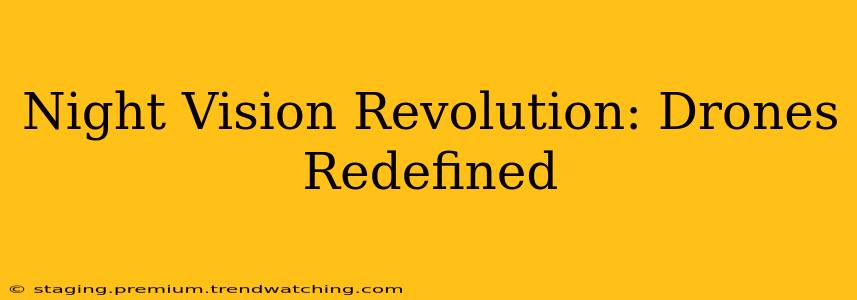The world of drones has undergone a dramatic transformation, largely thanks to advancements in night vision technology. No longer limited to daylight operations, drones equipped with sophisticated night vision systems are revolutionizing various industries, from search and rescue to security and surveillance. This article delves into the exciting advancements in drone night vision, exploring its capabilities, applications, and the future of this rapidly evolving technology.
How Does Night Vision on Drones Work?
Drone night vision capabilities are primarily achieved through the use of thermal imaging and low-light cameras.
-
Thermal Imaging: This technology detects infrared radiation emitted by objects, creating images based on temperature differences. Warmer objects appear brighter, allowing operators to easily identify people, animals, and even machinery in complete darkness. This is particularly useful for search and rescue operations where finding a lost person in the dark is critical.
-
Low-Light Cameras: These cameras utilize advanced sensors and image processing techniques to enhance visibility in low-light conditions. While not as effective as thermal imaging in complete darkness, they offer superior image detail and color representation, making them ideal for situations requiring higher visual acuity. Some advanced systems combine both thermal and low-light capabilities for a comprehensive night vision solution.
What are the Different Types of Drone Night Vision Systems?
Several types of night vision systems cater to various needs and budgets:
-
Integrated Systems: These systems are built directly into the drone, offering a streamlined and convenient solution.
-
Add-on Systems: These are external cameras or sensors that can be attached to existing drones, providing an upgrade in night vision capabilities. This offers flexibility for those who already own a drone and want to enhance its nighttime performance.
-
Analog vs. Digital: Analog systems are generally less expensive but offer lower resolution and image quality. Digital systems, on the other hand, provide significantly better image clarity and detail, though they come with a higher price tag.
What are the Key Applications of Night Vision Drones?
The applications of night vision drones are vast and continue to expand:
-
Search and Rescue: Locating missing persons in challenging terrain or during nighttime hours is significantly aided by thermal imaging, allowing rescuers to pinpoint heat signatures even through dense vegetation or fog.
-
Security and Surveillance: Drones equipped with night vision provide enhanced security for large areas, such as industrial sites, borders, or critical infrastructure. They offer a discreet and effective way to monitor activity in the dark.
-
Law Enforcement: Night vision drones assist law enforcement agencies in various operations, including tracking suspects, monitoring crime scenes, and providing aerial support during nighttime pursuits.
-
Wildlife Conservation: Researchers can utilize night vision drones to monitor wildlife populations, study animal behavior, and assess habitat conditions without disturbing the animals.
-
Infrastructure Inspection: Night vision allows for the inspection of bridges, power lines, and other infrastructure even at night, minimizing disruption and improving safety.
What are the advantages of using night vision drones?
Night vision drones offer a significant advantage over traditional methods of nighttime observation, providing a safer, more efficient, and cost-effective solution. They enable operations to continue regardless of light conditions, enhancing productivity and response times.
What are the limitations of using night vision drones?
While incredibly valuable, night vision drones have some limitations. Weather conditions such as heavy rain or snow can affect the performance of both thermal and low-light systems. Furthermore, the range and battery life of drones remain crucial factors, impacting operational time and coverage. Finally, regulations and legal considerations concerning drone operation at night vary by location, necessitating compliance with local laws.
How much does a night vision drone cost?
The cost of a night vision drone varies significantly depending on the type of system, the quality of the camera, and the drone itself. Prices can range from a few hundred dollars for simpler add-on systems to several thousand dollars for high-end, integrated systems with advanced features.
Are night vision drones legal to fly?
The legality of flying night vision drones depends on your location and local regulations. Many countries require specific permits or licenses for nighttime drone operations, and it's crucial to check with your local aviation authority before flying any drone at night. Safety and responsible operation are paramount.
The future of night vision drones is incredibly bright. Ongoing advancements in sensor technology, image processing, and drone autonomy will continue to improve performance, expand applications, and make this technology even more accessible. As the technology continues to evolve, we can expect to see even more innovative and impactful uses of night vision drones across various sectors.

